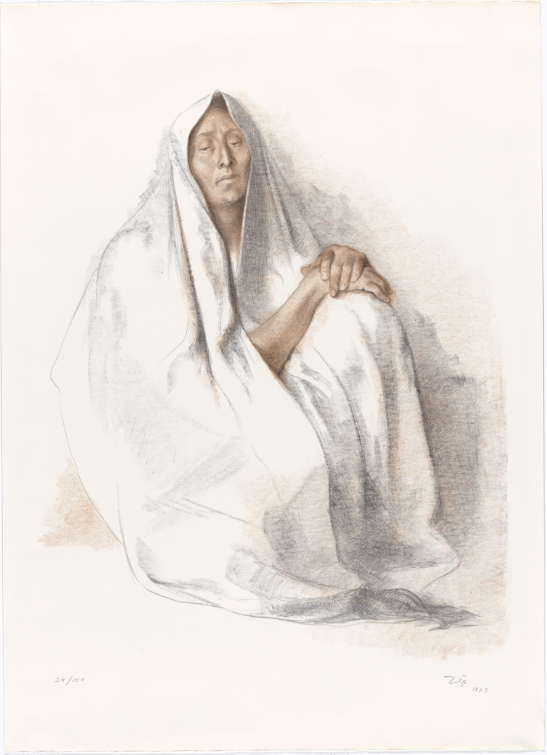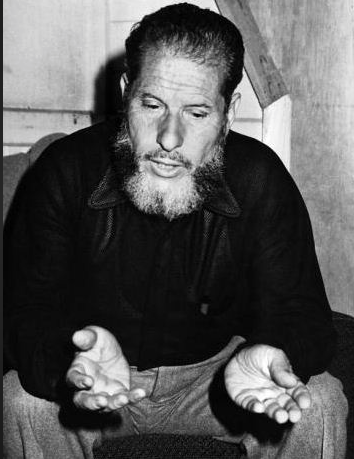

José Jesús Francisco Zúñiga Chavarría (December 27, 1912 – August 9, 1998) was born in Costa Rica and lived in Mexico most of his life. He is known both for his painting and his sculpture. Journalist and architect Fernando González Gortázar lists Zúñiga as one of the 100 most notable Mexicans of the 20th century, while the Encyclopedia Britannica calls him “perhaps the best sculptor” of the Mexican political modern style. Zúñiga was born in Guadalupe, Barrio de San José, Costa Rica, to Manuel Maria Zúñiga and María Chavarría, both sculptors. His father worked as a sculptor of religious figures and in stonework. His artistic inclinations began early and by the age of twelve had already read books on the history of art, artistic anatomy and the life of various Renaissance painters. At age fifteen he began working in his father’s shop. This experience sensitized him to shape and spaces. In 1926, he enrolled in the Escuela de Bellas Artes in Mexico, but left the following year to continue on his own.

Zúñiga created over thirty five public sculptures. In the 1940s he created two sculptures for Chapultepec Park, “Muchachas Corriendo” and “Física Nuclear.” In 1984 he created a group of sculptures called “Tres generaciones” for the city of Sendai, Japan. During his lifetime, these were considered his most important works. Since then, they have become secondary to his other sculpting.
He stated that he preferred figurative art because he found the human figure to be “the most important aspect of the world around (him)”. He was also strongly influenced by pre Hispanic art, spending significant time sketching pieces in museums, along with images of women in traditional markets, feeling that they represented maternity and familial responsibility.
Museums holding his works in their permanent collections include the San Diego Museum of Art, the New Mexico Museum of Art, the Metropolitan Museum of Art, the Museum of Modern Art in New York, the Museo de Arte Moderno in Mexico City, the Dallas Museum of Modern Art, the Ponce Museum of Modern Art in Puerto Rico and the Hirschhorn Museum and Sculpture Garden in Washington D.C.
José Jesús Francisco Zúñiga – Mujer Sentada con Rebozo Litografia / Litografía
José Jesús Francisco Zúñiga Chavarría (27 diciembre 1912 a 9 agosto 1998, nació en Costa Rica pero vivió en México la mayor parte de su vida, y es conocido por su pintura y su escultura. El periodista y arquitecto Fernando González Gortázar enumera Zúñiga como uno de los 100 mexicanos más notables del siglo 20, mientras que la Enciclopedia Británica lo llama “quizás el mejor escultor” del estilo moderno político mexicano. Zúñiga nació en Guadalupe, Barrio de San José de Costa Rica, sus padres fueron Manuel María Zúñiga y María Chavarría, ambos escultores. Su padre trabajaba como escultor de figuras religiosas, y en el trabajo de la piedra. Sus inclinaciones artísticas comenzaron temprano y a la edad de doce años ya había leído libros sobre la historia del arte, anatomía artística y la vida de varios pintores renacentistas. A los quince años comenzó a trabajar en la tienda de su padre. Esta experiencia le sensibilizó a la forma y espacios. En 1926 se inscribió en la Escuela de Bellas Artes de México, pero se fue al año siguiente para continuar por su cuenta.
Zúñiga ha creado más de treinta y cinco esculturas públicas. En la década de 1940 creó dos esculturas para el Parque Chapultepec llamadas “Muchachas Corriendo” y “Física Nuclear.” En 1984 se creó un grupo de esculturas llamadas “Tres Generaciones” para la ciudad de Sendai, Japón. Durante su vida, éstos se consideraron sus obras más importantes. Desde entonces, su otra escultura se ha destacado.
Dijo que prefiere el arte figurativo porque considera que la figura humana es “el aspecto más importante del mundo a nuestro alrededor”. También fue fuertemente influenciado por el arte prehispánico y pasó mucho tiempo dibujando piezas en los museos, junto con imágenes de mujeres en los mercados tradicionales. Pensaba que estas figuras femeninas representaban la maternidad y las responsabilidades familiares.
Museos que llevan a cabo sus obras en sus colecciones permanentes incluyen el San Diego Museum of Art, el Museo de Arte Nuevo México, el Museo Metropolitano de Arte, el Museo de Arte Moderno de Nueva York, el Museo de Arte Moderno de la Ciudad de México, el Museo de Dallas de Arte moderno, el Museo de Arte de Ponce en Puerto Rico moderno y el Museo Hirschhorn y Jardín de Esculturas en Washington DC.
